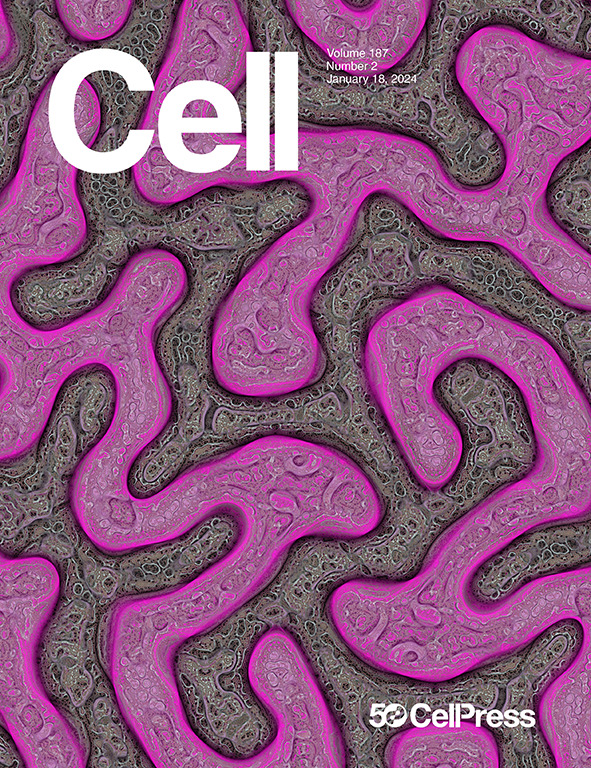脑淋巴发育的神经活动调节和神经胶质介导控制
IF 45.5
1区 生物学
Q1 BIOCHEMISTRY & MOLECULAR BIOLOGY
引用次数: 0
摘要
在生理和病理条件下,神经系统调节外周免疫反应,但大脑对免疫系统发育的影响尚不清楚。嵌入脑膜壁淋巴内皮细胞(muLECs)在脑周围形成免疫生态位,有助于脑免疫监测。在这里,我们报道了大脑通过一个特殊的胶质亚群slc6a11b+放射状星形胶质细胞(RAs)控制mulec的发育,这一过程由斑马鱼的神经活动调节。slc6a11b+ RAs,其突起延伸至脑膜,通过表达血管内皮生长因子C (vegfc)控制muLEC的形成。此外,神经活动调节muLEC的发育,而这种调节需要Vegfc参与slc6a11b+ RAs。有趣的是,slc6a11b+ RAs与钙结合EGF结构域1 (ccbe1)+成纤维细胞合作,通过控制成熟Vegfc分布来限制脑表面muLEC的生长。因此,我们的研究揭示了神经胶质介导和神经活动调节对脑淋巴发育的控制,并强调了组织间细胞合作在发育中的重要性。本文章由计算机程序翻译,如有差异,请以英文原文为准。

Neural-activity-regulated and glia-mediated control of brain lymphatic development
The nervous system regulates peripheral immune responses under physiological and pathological conditions, but the brain’s impact on immune system development remains unknown. Meningeal mural lymphatic endothelial cells (muLECs), embedded in the leptomeninges, form an immune niche surrounding the brain that contributes to brain immunosurveillance. Here, we report that the brain controls the development of muLECs via a specialized glial subpopulation, slc6a11b+ radial astrocytes (RAs), a process modulated by neural activity in zebrafish. slc6a11b+ RAs, with processes extending to the meninges, govern muLEC formation by expressing vascular endothelial growth factor C (vegfc). Moreover, neural activity regulates muLEC development, and this regulation requires Vegfc in slc6a11b+ RAs. Intriguingly, slc6a11b+ RAs cooperate with calcium-binding EGF domain 1 (ccbe1)+ fibroblasts to restrict muLEC growth on the brain surface via controlling mature Vegfc distribution. Thus, our study uncovers a glia-mediated and neural-activity-regulated control of brain lymphatic development and highlights the importance of inter-tissue cellular cooperation in development.
求助全文
通过发布文献求助,成功后即可免费获取论文全文。
去求助
来源期刊

Cell
生物-生化与分子生物学
CiteScore
110.00
自引率
0.80%
发文量
396
审稿时长
2 months
期刊介绍:
Cells is an international, peer-reviewed, open access journal that focuses on cell biology, molecular biology, and biophysics. It is affiliated with several societies, including the Spanish Society for Biochemistry and Molecular Biology (SEBBM), Nordic Autophagy Society (NAS), Spanish Society of Hematology and Hemotherapy (SEHH), and Society for Regenerative Medicine (Russian Federation) (RPO).
The journal publishes research findings of significant importance in various areas of experimental biology, such as cell biology, molecular biology, neuroscience, immunology, virology, microbiology, cancer, human genetics, systems biology, signaling, and disease mechanisms and therapeutics. The primary criterion for considering papers is whether the results contribute to significant conceptual advances or raise thought-provoking questions and hypotheses related to interesting and important biological inquiries.
In addition to primary research articles presented in four formats, Cells also features review and opinion articles in its "leading edge" section, discussing recent research advancements and topics of interest to its wide readership.
 求助内容:
求助内容: 应助结果提醒方式:
应助结果提醒方式:


